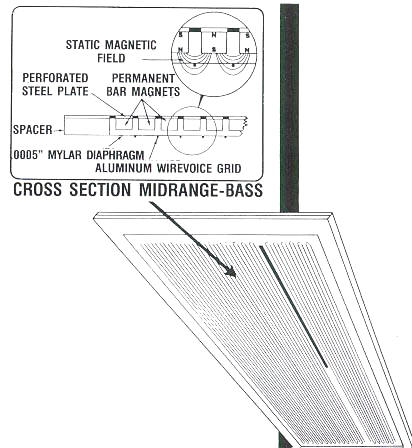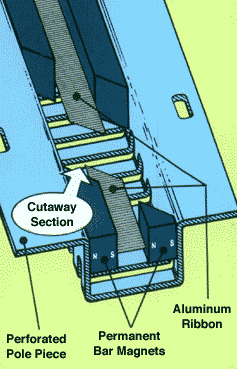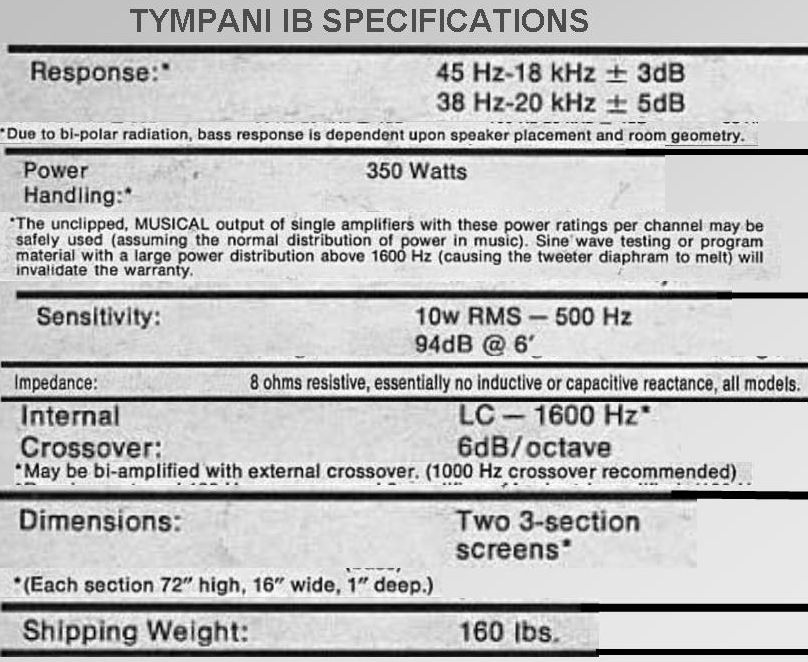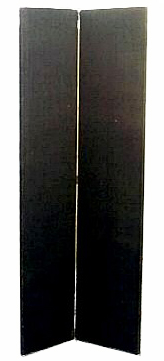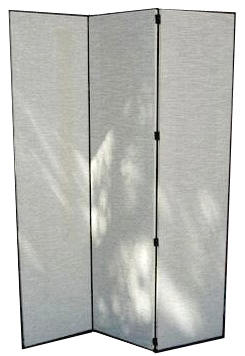|
MAGNEPLANAR TYMPANI SERIES
James Winey, President and also firm’s research and development engineer of Magnepan (White Bear Lake, MN,USA) introduced in 1971 the first full planar-magnetic loudspeaker of the world. This speaker, named Tympani, was formed by three screens for each side, two for mid-bass section and one for high frequencies, every one measuring 16"×71"×1" . In 1973 they introduced the Tympani 1-A and the Tympani III. Various models and versions were produced successively by Magnepan until 1985.
James Winey, Presidente e anche ricercatore della Magnepan (White Bear Lake, MN,USA) introdusse il primo diffusore acustico al mondo totalmente planare. Questo diffusore, denominato Tympani, era formato da tre pannelli per ciascun lato, di cui due per la sezione medio-bassi e uno per le alte frequenze, ciascuno con dimensioni 16"×71"×1". Nell’anno 1973 furono introdotti i modelli Tympani 1-A e Tympani III. Altri modelli e versioni delle Tympani furono prodotte successivamente fino al 1985.
The Planar-magnetic driver It consists in a large planar magnetic area of permanent magnetic field with a very thin (.0005”) film diaphragm (mylar) stretched over it. To the low mass mylar diaphragm are attached two long aluminum wires (one of more large diameter for mid-bass section and the other of lesser diameter for the high section). The wires are oriented in a vertical zig-zag pattern. “As the audio current passes through the wires, the interaction between the magnetic field around the conductors and the permanent magnetic field causes the entire diaphragm to move. The movement of the diaphragm creates sound waves which are accurate reproductions of the input waveforms.” (from the original Magnepan brochure) The Magnepan driver, however, is "single-ended". It is driven only on one side and the damping is mechanical only. Il Driver Planar Magnetic Esso è formato da una vasta area di magneti permanenti e da una sottile pellicola di materiale sintetico (mylar) distesa su di essi. Su tale membrana sono attaccati due lunghi fili di alluminio (uno di diametro superiore per la sezione medio-bassi e uno di diametro inferiore per la sezione alti). I fili sono disposti verticalmente a zig-zag. “ Al passaggio del segnale audio attraverso i fili, l’interazione tra il campo magnetico intorno ai conduttori e il campo magnetico permanente dei magneti stessi determina il movimento dell’intero diaframma di mylar. Il movimento del diaframma crea le onde sonore che sono una riproduzione accurata delle onde sinusoidali del segnale di ingresso.” (dalla brochure originale della Magnepan) Il driver Magnepan quindi è di tipo “single-ended” in quanto agisce in una sola direzione mentre il rilasciamento della membrana è solo di tipo meccanico.
The direction of force on a positive charge or a current is determined by the right-hand rule. The right-hand rule is a common mnemonic for understanding notation conventions for vectors in 3 dimensions. It was invented by British physicist Ambrose Fleming in the early 1900s. Hold the thumb, index and middle fingers at right angles to each other. Make sure that the thumb and index finger form an "L" or a gun shape. Thus, if the thumb represents the direction of the current and the index indicates the magnetic field, then the middle finger represents the direction of the movement. The waveforms are radiated alternately front and back (the so called di-polar radiation which is completely different from the bi-polar radiation of two conventional cone speaker located front and rear in a same box, where the front and back work against each other).
La direzione della forza alla variazione di corrente è determinate dalla cosiddetta “legge della mano destra” che è una comune formula mnemonica per i vettori a tre dimensioni, inventata dal fisico inglese Ambrose Fleming nei primi del 900. Posizionare il pollice,l’indice e il medio ad angolo retto fra di loro. Assicurarsi che pollice e indice formino una “L” a guisa di pistola. Pertanto, se il pollice rappresenta la direzione della corrente e l’indice indica il campo magnetico, il medio indicherà allora la direzione del movimento. Le onde sonore saranno irradiate alternativamente in avanti e all’indietro (la cosiddetta radiazione di-polare che è completamente diversa dalla radiazione bi-polare di due altoparlanti convenzionali situati in avanti e all’indietro sullo stesso cabinet, laddove quello frontale e il posteriore lavorano in maniera antagonista).
The planar magnetic driver, named too quasi-ribbon, is different from the true ribbon driver. A true ribbon is defined by a thin ribbed aluminium foil which act as the voice-coil. It is dedicated to very high frequency in high quality loudspeaker. Due to the very low impedance it needs generally a transformer coupled to the amp. The ribbon tweeter was first introduced by Quad, but a few years later developed by Stanley Kelly. His speaker was the Kelly 30 with a rather small horn which was positioned vertically. The design of the Kelly 30 was taken over by Decca who manufactured the Decca Kelly 30 (DK30) and the bigger Decca London Ribbon. Il driver planar magnetic, denominato anche quasi-ribbon, è diverso dal vero driver ribbon (driver a nastro). Infatti un vero ribbon consiste in un sottilissimo foglio di alluminio che agisce quale “voice-coil”. Esso è particolarmente adatto per le alte frequenze e in genere, per la sua bassissima impedenza, richiede l’utilizzo di un trasformatore accoppiato all’amplificatore. Il primo tweeter ribbon fu introdotto dalla Quad ma dopo qualche anno fu ulteriormente sviluppato da Stanley Kelly che ideò il Kelly 30 nel quale una piccola tromba fu posizionata verticalmente. La struttura del Kelly 30 fu ripresa dalla Decca che costruì il Decca Kelly 30 (DK30) e il modello più grande Decca London Ribbon.
The electrical signal is applied to the ribbon which moves with it, thus creating the sound. Early ribbons electromagnetically pushed outward with the musical waveform, and used their natural elasticity as a restorative or return force. So they are named single-ended or push ribbon tweeters. Unfortunately they produced high levels of distortion. Later designs utilized magnets on both sides of the diaphragm resulting in a push-pull design. Push-pull ribbons are typically far more accurate than single-ended ribbons; they usually have higher power handling capacities as well, since diaphragm motion was far more tightly controlled.
Il segnale elettrico viene applicato al ribbon che vibrando crea il suono. Nei primi ribbon il movimento avveniva verso l’esterno durante il passaggio del segnale e era solo la loro elasticità ad essere impiegata quale forza di ritorno. Pertanto essi furono denominati tweeter single-ended o push-ribbon. Sfortunatamente essi producevano elevati livelli di distorsione. Nei progetti successivi furono utilizzati magneti piazzati su entrambi i lati della lamina realizzando in tal modo un push-pull tweeter. I ribbon push-pull sono caratterizzati da una maggiore accuratezza rispetto ai single-ended e tollerano maggiori potenze, giacchè il movimento del diaframma è più accuratamente controllato.
Magneplanar introduced his first true ribbon tweeter in 1880’s in the Tympani IV and MGIII models (see note below). This ribbon is very narrow (2.5 micron) and corrugated aluminium foil. It allows conventional ferrite magnets to create more efficiency and plus high resistive impedance for direct drive without the requirement of a transformer. The ribbon introduced in the Tympani IV version is really the first ribbon tweeter produced by Magneplanar. It is different from the planar push-pull midrange/tweeter used in the Tympany I-D. The I-D is a two way system that uses a push-pull planar magnetic driver formed by a membrane sealed in a metal casing affixed to the panel. The tweeter is encased in magnets on both sides front and back sides and covered the range from 1000 Hz to 20,000 Hz. La Magneplanar introdusse il suo primo vero ribbon tweeter negli anni 80 nei modelli Tympani IV e MGIII (vedi la nota successiva). Questo ribbon è costituito da un foglio di alluminio corrugato e molto sottile (2.5 micron). Ciò permette ai magneti in ferrite una maggiore efficienza e una più alta impedenza, con la possibilità di un pilotaggio diretto senza la necessità di un trasformatore. Il ribbon introdotto nella Tympani IV fu realmente il primo ribbon prodotto dalla Magneplanar. Esso è differente dal midrange/tweeter planare a push-pull utilizzato nella Tympani I-D. La I-D infatti usa un driver planare di configurazione push-pull formato da una membrana sigillata in un involucro metallico fissata al pannello che è circondata dai magneti in entrambi i lati (avanti e dietro) e che riproduce la gamma sonora dai 1000 ai 20.000 Hz.
TYMPANI I
Tympani I (1971) : As reported by many Audiophiles, the early Tympani was 8 panels and was followed successively by the 6 panels version. I never seen this 8-screen early version but only the 6-screen version. Basically is a two ways planar loudspeaker (2 panel for bass, one or two for mid-high frequencies for each side). Sometimes it is referred to as I-U, where the "U" stands for Utility fabric as opposed to I-DF (Designer Fabric) material used for the sock. Impedance : 8 Ohms Dimensions : 16"×71"×1"
I will be very grateful to everyone which let me know further information about this speaker.
Come riportato da alcuni Audiofili, la Tympani prima versione sarebbe costituita da 8 pannelli e fu sostituita dalla successiva versione a 6 pannelli. Io non ho mai visto questa prima versione ma solo quella a 6 pannelli. Si tratta essenzialmente di un diffusore planare a due vie ( 2 pannelli per i bassi, uno o due per le frequenze medio-alte per ciascun lato). Qualche volta viene denominata anche Tympani I-U , laddove la “U” sta per Utility oppure I-DF (Designer fabric). Impedenza : 8 Ohm Dimensioni : 16"×71"×1"
Sarò molto grato a tutti coloro vorranno fornirmi ulteriori informazioni su questo diffusore.
Two-way, 6 screens loudspeaker similar to the previous model. Impedance : 8 Ohms Dimensions : 16"×71"×1"
Diffusore a due vie, 6 pannelli, simile al precedente modello.
Tympani I-B (1974) : Two-way, 6 screens (2 panel for bass, 1 for mid-high frequencies for each side) As reported in Maggie Users Group, (http://www.integracoustics.com/MUG/MUG/articles/speakers.html) in this model was firstly introduced the planar magnetic push-pull tweeter. As others, the planar push-pull tweeter was introduced only successively in the Tympani I-D version.
Due vie, 6 pannelli ( 2 per I bassi, 1 per le medie-alte frequenze per ciascun lato) Come riportato da “Maggie Users Group”, (http://www.integracoustics.com/MUG/MUG/articles/speakers.html) in questo modello fu introdotto per la prima volta il tweeter planare di tipo push-pull. Secondo altri invece, questo tweeter fu introdotto solo successivamente nella versione Tympani I-D.
Tympani I-C (1975) : Two-way, 6 screens (2 panel for bass, 1 for mid-high frequencies for each side).This speaker has the fully planar system configuration.
Due vie, 6 pannelli ( 2 pannelli per I bassi, 1 per le medie-alte frequenze per ciascun lato). Questo diffusore ha una struttura totalmente planare.
Tympani I-D (1980?) : This was the last model of Tympani I series. 2 way, 6 screens, 4 Ohms impedance. In this model was introduced the push-pull planar magnetic mid-tweeter. The membrane of the mid-tweeter section is encased in magnets on both sides front and back sides. Thus it is a push-pull driver and it cover the range from 1000 Hz to 20,000 Hz. The Tympani I-D ceased production in 1982 thereabouts. Is available on request the Tympani I-D manual.
E’ stato l’ultimo modello della serie Tympani I. 2 vie, 6 pannelli, impedenza 4 Ohm. In questo modello fu introdotto il primo mid-tweeter planare tipo push-pull. La membrana della sezione medio-alti è circondata dai magneti in entrambi i lati. Pertanto si tratta effettivamente di un mid-tweeter planare tipo push-pull che riproduce la gamma dai 1000 ai 20.000 Hz. Questo diffusore uscì di produzione all’incirca nel 1982. E’ disponibile a richiesta il manuale della Tympani I-D.
TYMPANI II
4 screens (one bass and one mid/tweeter for each side). Introduced in 1980’s. Today pretty rare model. Sorry, specifications are not available.
I will be very grateful to everyone which let me know further information about this speaker.
4 pannelli (uno per i bassi, uno per le medie-alte frequenze).Introdotto negli anni 80. Oggi è un modello molto raro. Spiacente, ma non possiedo le caratteristiche.
Sarò molto grato a tutti coloro vorranno fornirmi ulteriori informazioni su questo diffusore.
TYMPANI III
Magneplanar introduced this version in 1973. 3 way,8 screens ( four woofer panels – two pair midrange/tweeter panels). No internal cross-over because these speakers was designed for bi-amplification. The tweeters shows the planar push-pull configuration.
La Magneplanar presentò questa versione nel 1973. 3 vie, 8 pannelli ( 4 per i bassi, 2 paia midrange/tweeter). Assenza di crossover interno in quanto questi diffusori sono progettati per la bi- amplificazione. I tweeter mostrano una configurazione planare a push-pull.
Tympani III-A (1975) : Similar to the previous model.
Simile al precedente modello.
Tympani III-B
3-way, 8 screens ( four woofer panels – two pair midrange/tweeter panels) It differentiate from the previous model for impedance (4 Ohms), power handling (200 w) and sensitivity (84 dB).
Is available on request the Tympani III-B manual.
3 vie, 8 pannelli (quattro per i bassi, 2 paia midrange/tweeter) Si differenzia dal modello precedente per l’impedenza (4 Ohm), la potenza massima (200 W) e la sensibilità (84 dB) E’ disponibile a richiesta il manuale della Tympani III-B.
TYMPANI IV
As reported in Maggie Users Group (http://www.integracoustics.com/MUG/MUG/articles/speakers.html) Magnepan released the Tympani IV in 1975. Instead many Audiophiles claimed that in this model was introduced the very first ribbon tweeter of the Tympani series (the same ribbon tweeter used in 1984 in the MG-III). Therefore, i think that Tympani IV was released later (1980’s) or, if the year of his born is really 1975, the early Tympany IV do not had probably a true ribbon tweeter. The Magnepan’s press release (see below) included in the Tympani IV-A manual, regarding the changes between the IV and IV-A model, don’t seem indicate change in tweeter design, so it can assume that in both was present the true ribbon driver.
Come riportato da “Maggie Users Group” (http://www.integracoustics.com/MUG/MUG/articles/speakers.html), la Magnepan avrebbe introdotto questo diffusore nel 1975. Molti Audiofili invece affermano che in questo modello fu introdotto il primo vero tweeter ribbon della serie Tympani ( uguale a quello usato nel 1984 per la MGIII). Dunque io penso che la Tympani IV fu introdotta più tardi (negli anni 80) oppure, se l’anno di nascita fu effettivamente il 1975, la prima Tympani IV non aveva probabilmente un vero tweeter di tipo ribbon. La nota di stampa della Magnepan inserita nel manuale della Tympani IV-A, concernente le variazioni tra i modelli IV e IV-A, non sembra indicare alcuna variazione nella progettazione del tweeter, quindi si può ipotizzare che in entrambi sia presente lo stesso ribbon tweeter.
Tympani IV-A (1985) : 3-way, 6 screens (2 woofer,1 mid-tweeter). Bass section : 1254 SQ – Mid section: 168 SQ. – Treble section: ¼ “ W x 55” L x 0001-00015” T The cross-over components between the bass and midrange tweeter hare housed in a pair of external crossover boxes. The midrange/ treble crossover components are housed in the mid-treble panel. The ribbon push-pull tweeter is housed in the mid-treble panel. The speakers are designed for conventional amplification but providing bi-amplification as an optional.
3 vie, 6 pannelli ( 2 woofer, 1 per medie-alte frequenze) Sezione bassi : 1254 SQ – Sezione Medi: 168 SQ. – Sezione alti: ¼ “ W x 55” L x 0001-00015” T
Is available on request the Tympani IV-A manual
E’ disponibile a richiesta il manuale della Tympani IV-A.
TYMPANI SERIES
|
